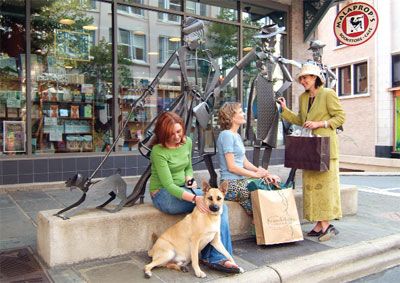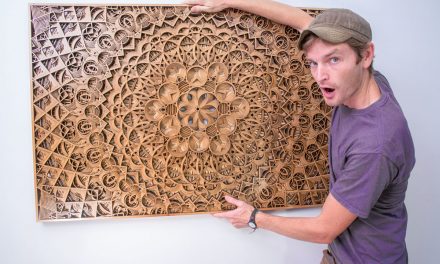Elsa Mikus spent decades in the corporate world, working in what she describes as a “dizzying array of jobs, ranging from file clerk to software tester.” However, it’s her most recent incarnation as an artisan that has brought her the most success and the greatest fulfillment.
“I was always making something from the time I was a kid – first doll clothes, and then graduating to making all of my own clothes in high school,” says Mikus, who runs Tempest in a Teapot with longtime friend and business partner, Barbara C. Ryan. “In 1985, I discovered tole/decorative/folk art painting and got hooked on it after my first craft show in 1989. I also made primitive dolls for a couple of years.”
It took another decade of doing craft shows alongside her corporate job before she gave herself permission to pursue “a more artful life;” it was a decision that proved to be a godsend to her and Ryan, who had also spent years in less-than-satisfying corporate and teaching roles. Together, the two artisans now transform discarded pieces of silver into whimsical wind chimes and stunning pieces of jewelry. In addition to a flourishing wholesale business that sells their finished pieces to points all over the country, they sell through craft shows, home parties, their website (www.tempestinateapot.net), and out of a small store front located within Wickit Good Candles in Point Pleasant, New Jersey.
The two artists also take on custom orders – personalizing the pieces to suit a client’s taste or preference – and frequently complete custom orders that incorporate family heirlooms. Their pieces, both standard and custom, begin at $25, but they can sell for as much as $200 for more elaborate designs.
“It isn’t always easy, but we’ve been able to make it just on our handwork alone,” says Mikus from their studio in Point Pleasant. “We’ve had to make some adjustments when the economy took a downturn, but we committed to it, and it’s working.”
Their success is great news to a burgeoning clientele, which is delighted with the fanciful items the two produce from pieces of silver that once serviced more elegant and refined lifestyles. “You look at some of these silver coffeepot and teapots and think about where they came from and how they were used,” says Mikus. “For us, it’s a chance to give them new life, and to recycle items that may have had sentimental value. We see people at craft shows recognize their mother’s or their grandmother’s silver pattern or whatever, and they just burst into tears. People think it’s great to see this stuff used again.”
Perhaps even more importantly, Mikus said that they are introducing a whole new generation to these objects of gentility. “Since I started making the jewelry,” she says, “some of the high school/college-age students think they have ‘discovered’ spoon rings! When I tell them that they have been around since the 1960s, they think I’m kidding.”
Their raw materials are salvaged from flea markets and auctions in Pennsylvania and New Jersey, which they used to frequent until time constraints forced them to hire someone to scour for them. “We have someone who does that for us now. At first, he picked up everything,” she laughs. “Now, he knows exactly what we’re looking for.”
The artists’ early success at craft shows convinced them that they finally found their niche. “If you look at them as a piece of Americana, glorified junk, or recycled history, it’s clear that these chimes cross ethnic and religious boundaries,” says Mikus. “After the reaction we got to our wind chimes at our first craft show in 2001, we knew we were on the right track. We said, ‘look, these pay the bills,’ and we haven’t looked back.”
Mikus said she drew on a lifelong interest in jewelry to further hone her metalsmithing skills through classes she took in 2009. “I wanted to learn how to saw, solder, fuse, and a lot of other techniques needed to make jewelry look more professional,” she says. That same year, the two launched a new line of jewelry that includes necklaces, bracelets, and rings from silver-plate flatware that dates back to the late 1800s. As with their wind chimes, many pieces also incorporate whimsy in the form of antique buttons, copper, brass, and handmade glass buttons.
“When we only sold at craft shows, and each piece was extremely different, we’d have the best time going to flea markets and buying whatever struck our fancy,” says Mikus. “We’d buy whatever we thought we could make a chime out of – you name it, orthodontic discards, tiny brass bathtubs, or beat-up bugles. It was a lot of fun to have that kind of creative freedom.”
The wholesale aspect of their work took off following a Buyer’s Market of American Craft show in Philadelphia in August 2005, when they came home with orders that guaranteed them income clear into the following spring. “That first year and half that we did wholesale, we were booked solid,” she said. “But, you do miss the freedom to create new pieces. With wholesale, you have to produce the pieces people saw; you can’t stray too far from that.” But, she says, “I’d like to throw in a bathtub every now and then.”
The real creativity comes with many of the custom orders made for weddings, anniversaries, and other special occasions. One recent piece completed for a bride combined different pieces of family jewelry. Other pieces have included a grandmother’s pearls, a grandfather’s pocket watch, pins, brooches, and even wedding bands. “It’s another way to give life to those pieces that have so much meaning to people,” she says. “And when you see how people respond to it….well, that’s really great, too.”
Timing is Everything
The fortuitous confluence of events that led to the launch of their business a decade ago involved good timing – a factor that is hard to overlook when considering success as an artisan. Friends of Ryan and Mikus decided that they, too, were taking a new path in life, and they wanted to pass along their acquired skills in metalsmithing, as well as their equipment. They offered to teach the two women their techniques, and both Ryan and Mikus embraced the new medium enthusiastically. They quickly evolved into accomplished artisans and began adding their own creative flourishes.
Two rooms of their home were given over to the business, which was quickly successful. It wasn’t until the economy tanked in late 2008 that they decided to go back to craft shows, and they added other avenues for exposure. “It’s not exactly a great time to make a living doing this sort of thing,” Mikus says. “It’s a lot more difficult to rely only on this for a source of income. But we’ve built up a fairly loyal clientele over the years, and we’ve been able to acquire some retail space in a local shop, so it works.”
What advice would Mikus give to others? “Don’t give up your day job right now,” she laughs.
She also offers aspiring artisans the following tips:
1. If possible, maintain physical separation between work and personal life.
Although this isn’t often an option for those hoping to launch a business, Mikus says moving their studio from their living and dining room to a small warehouse space was one of the best decisions they made. “It was such a relief to get away from it,” she says. “When the studio was in our home, the business was on my mind from the minute I got up in the morning until I went to bed at night. Unless you’re really disciplined and can get up and walk away from it, it’s hard to gain some perspective and get really relaxed and renew your creative energy.”
2. Take advantage of the opportunities to learn from fellow crafters.
“At craft shows, we found that people there are more than willing to share where the good shows are, where to find teachers, and even where to get bargains on supplies.” The two also network through social media outlets, but admit that they have a lot to learn. “We’ve been on Facebook for a couple of months now, and we are building our fan base,” she says. “I’m still trying to figure out the purpose of Twitter.”
3. Don’t be afraid to change what you are doing.
“If what you are making doesn’t sell, revamp your product line or change mediums altogether,” she says. “I went from painting to primitive dolls – neither of which paid the bills – to the wind chimes.”
4. Experiment with techniques that are popular with other crafts.
“I am always looking at mixed media techniques to find new methods or supplies,” says Mikus, who recognizes that evolution as an artist is a never-ending journey. “Take classes with teachers that you admire and use their techniques, not their finished products, to keep your line fresh.”
5. Adjust your business model to conform to economic realities.
Following their explosive success at early retail craft shows, and a nudge of a fellow artist, the two women began doing wholesale in 2005. This venture proved to be so successful that they didn’t need to do craft shows for five years. When the disposable income of so many buyers dried up during the economic downturn, the two got back on the craft show circuit, secured a retail store front, make sure their website is current, and look for every opportunity to gain exposure for their work.
For more information, please go to www.tempestinateapot.net, or call (732) 598-4690, or visit the retail shop at 604 Route 88 East, Point Pleasant, NJ 08742.





